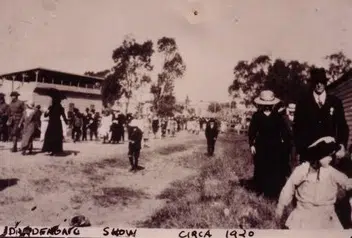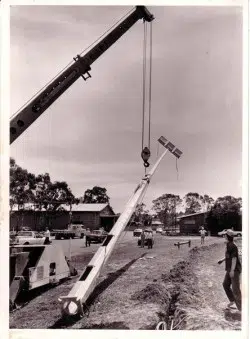


Since the early 1820’s
Agricultural and pastoral societies have played a central role in developing and promoting new farming technology while blending entertainment, commerce and education with popular culture. The scope of agricultural shows has progressed from cattle fairs and ploughing matches to becoming multi-faceted events featuring commercial, government and entertainment activities.
The Dandenong Agricultural & Pastoral Society has shared in the ups and downs of the area, it has weathered good and bad times, periods of apathy, financial difficulties, bank crashes, the bursting of the land boom bubble, two world wars, three ground changes, flood, bush fires and drought.
That it has survived and prevailed, is due to the community spirit of its leadership, right from the pioneering days. Most agricultural societies rely on volunteer effort, goodwill and dedication of office-bearers and members, and no society has a stronger tradition of children following their parents through the ranks, continuing their dedication to the past works of this institution. Back in 1871, Dunbar’s Hotel in the main street of Dandenong, was very much the civic centre of the struggling little market town, so it was hardly surprising that a preliminary meeting to discuss the launching of an agricultural show was held there on Saturday May 27.Our pioneers were obviously men of action, for only three days later, at a public meeting in the Dandenong Market – what better place for the birth of an agricultural society – the Dandenong and South Bourke Agricultural Association was launched.
The Society, older than the Dandenong Municipality, was no doubt inspired by the formation in 1856 of the Mornington Farmers’ Society at Berwick and Cranbourne and the two organizations undoubtedly built up a friendly rivalry which spurred each to greater efforts.
The first show was held at the Dandenong Market site on Thursday 7th March 1872 (in those days the Market site was located in the area bounded by Foster, Thomas, Mason and Walker Streets). The initial show had offered competitions in 54 sections. Top prize was £3 for the best draught horse, as befitted the horse’s importance in the district in those tough early years. Entries totaled 301, including two casks of colonial beer, 42 horses, 40 cattle, 6 sheep, 27 pigs, 16 cheeses, 14 butter, 52 fruit, 8 flowers, 7 honey, 1 egg, 18 poultry, 49 farm produce and a few others classified as ‘special mixed’. £24.19.0 was paid out in prize money with special prizes of bone-dust for the winners of the wheat, oats, barley and potatoes.
As it was too wet to include a ploughing match, this was held off until May 23rd with 16 entries received. The matches were held in Prevot’s Paddock. Sadly that same year, the society lost its foundation president William Keys, drowned whilst trying to rescue cattle in floods at Bangholme. By 1874 the Show had really ‘caught on’ seeing prize money creep up to £145. The Show acquired new status in 1876 when the Governor, Sir G. Bowen attended, and in November 1877 two half-acre allotments adjoining the Society’s showyards were bought from John Hemmings.
In 1878 the Minister for Railways allowed special trains, with excursion tickets, to run from the suburbs of Melbourne to the Show. 1881 was the year the thriving 10 year old Society ran into its first space problems. The entries were so numerous crowding in the yards led to demands for more space. Something new for 1882 was a horse-showing competition and a trotting track was added to the showgrounds.


There were always improvements being undertaken and in 1888 a new exhibition hall was built. The building was a major event not only for the Society, but for the community, because it provided a larger meeting place than the Mechanics Institute and the Town Hall was not built until 1890.
As befitted such a milestone, the South Bourke and Mornington Journal described the new exhibition building as “substantial commodious and handsome, situated on an elevated site, commanding an excellent view of the surrounding country and midway between the centre of the township and the railway station. A long felt want is now supplied by the beautiful building just completed, which undoubtedly has few equals in the colony. The new structure consists of wood with a galvanized iron roof and contains a total area, for exhibition purposes of 285 ft.”
This pavilion housed the refreshments, poultry, farm produce and band (the players to be seated behind a handsome iron balustrade overlooking the front portion of the grounds). A 10 x 10 ft water tank was constructed at the rear. The hall was lit with gas, a large chandelier containing about 30 burners being fixed in the centre with a smaller one at each end. Government subsidies, which were based on 2/3rds of prize monies distributed, were substantially slashed in 1892 which severely affected funds of the society.
As it was universally conceded that the proposed sale of the old showground and a new set-up in the Clow St. Market Reserve would be ‘to the advantage of the society and district’, in 1907 the show was held in the new Showgrounds, on a 10 year lease from the Council who stipulated where to place the pavilion (which was relocated from the old site), fencing, oval trotting course formed in the middle with pens placed on east & west sides for the animals. A grandstand was added in 1912, having been purchased from Caulfield Racecourse for £150. Funds were raised by the issue of 35 x £5 debentures and a ‘Village Fair” organized by the Ladies committee.
The Society decided to change it’s name at this time. Now it became, and has remained ever since:
THE DANDENONG AGRICULTURAL & PASTORAL SOCIETY.
At the Jubilee Show, a new feature was introduced on the suggestion of Mr. A. C. W. Bailey – The Grand Parade. Thursday 1st December was declared a public holiday for the show and the town’s business people assisted by closing their establishments. The State Governor, the Earl of Stradbroke, honored the Society by attending and officially opening the show. Entries that year set a new record of 1194 people, never had the society held such a large show. Something new for Dandenong was the advertising of local industries with special exhibits by local firms and some from the metropolis.
1923 “It was significant of changing times that at this show ‘motor exhibits competed with jinkers and buggies” Ansaldo, Berliet, Dodge, Ford and Chevrolet cars were displayed by local agents. 1924 show (opened by Hon SM Bruce Prime Minister) ‘underlying the impending transition to motor transport it was reported that ‘motor cars to the value of several thousands of pounds were parked in the carriage reserve, to say nothing of buggies, gigs, waggonettes and other means of vehicular transport’. In 1927 – luncheon speeches were broadcast on radio station 3LO. Wes Williams’ amplifiers appeared in the show ring for the first time in 1933. 1936 saw the show day change from the traditional Thursday to the second Saturday in November, which still remains in place today.
Dandenong had no showground in the early 1940s – the Army had taken the area – but two successful combined shows were held with Berwick in 1940 & 1941. Alas, while the Army were still in residence, the show Grandstand burnt down in 1944. Dandenong was still a country town in 1945, surrounded by farms and a scattering of rural villages at Springvale, Noble Park, Keysborough and Hallam. Farmers on horseback, were still droving their cattle through Dandenong’s streets to market. Some manufacturing industry was being introduced: Ordish Fire Brick Works; Dandenong Bacon Factory and Dandenong Butter Factory, along with a migration boom which was to see Dandenong on the doorstep of a change from rural to urban. Fat cattle were introduced for the first time in 1946 and in 1951 Olympic jumps for equestrians.




1954 seems to be the year when the Show, became more as we know it today. Without sacrificing any of the traditional ‘man of the land’ features, the show’s general appeal was being broadened. Many more activities had begun, mannequin parades, sheep shearing, dog obedience, the show was widely publicised and the Apex Club of Dandenong’s charity stands/spinning wheel enlivened side-show alley and became a regular feature. Port Phillip Affiliated Societies and Young Farmers were up and running. With the advent of television about this time, the “Sun” Miss Show Girl competition was introduced (1957) and TV stars were prominently used for the wheel and judging of the Show Girl quests.
Dandenong was proclaimed a city in 1959 and cars were banned from the showgrounds that year due to lack of space. Hansard of October 14, 1961 outlined the 1961 Dandenong Land Act Bill, enabling the City of Dandenong to transfer the rights of the Society from the Clow Street site to the Greaves Reserve of 57 acres.
In 1962 the pavilion which had been the pride and joy of the society since 1888 and which had survived a move from the old site, burnt down. That same year the society also lost the football changing rooms to fire.
The 1965 show attracted the second highest ‘gate’ on record – $3737 and entries climbed to an all-time high of 3818. The last of the Clow Street shows had a wet farewell, but did not deter 10,000 people from attending. The show had been held on Clow Street site for 59 years.
1967 was the first show held at Greaves Reserve (which was named after the late William Greaves who donated a portion of the land) and it was a record breaker – 4175 entries and the gate was $4234. The society announced $82,000 was to be spent over the next three years on providing amenities on Greaves Reserve. The State Government gave a grant of $20,000 for the first year with a further $30,000 on a $2 for $1 basis to be spent over 3 years.
The 1970 show was probably the most complete ever staged when entries topped 5480 and attendance climbed to 30,000.
As 1971 came around, there was great excitement and extra effort put in to celebrate 100 years of the society. It was decided to hold a 2 day event and the Minister of Agriculture Mr. G. L. Chandler, MLC, awarded the occasion the title of Grand National Centenary Show. The show was opened by the Governor Sir Rohan Delacombe, accompanied by Lady Delacombe. A special book titled “A Show Ring Saga” chronicling the first 100 years of the Dandenong Agricultural & Pastoral Society was written by Greg Dickson.
Improvements to the Show grounds on Greaves Reserve were undertaken over the next few years, by way of erecting arena fencing, galvanized seating around the arena and the installation of power. In 1973 an additional 8 acres of land west of the creek near Hanna Street was obtained on licence from the CRB (Country Roads Board). By 1973 plans were undertaken to establish an Administration building to be erected as the Society’s headquarters and meeting room. A co-operative was formed and shares issued to raise the necessary additional funds required.
Ringwood Building Co. was the successful tender for $64,566 (after cooling/heating were removed from the original quote). The building was constructed of solid clay bricks with inter-locking steel roof. Due to a delay in completion the formal opening as planned did not proceed, but the new facility was used for the first time for a general committee meeting on 9th November 1976 and then that following week-end for members’ hospitality and amenities at the Show.
On the 5th November 1986 –four lighting towers were erected around the main arena to allow lighting of the main arena for Saturday night attractions. As usual, the man power was provided by the dedicated team of volunteers.
Another huge voluntary operation was undertaken commencing in 1999 and culminating in 2002 with the completion of the Historic Cattle Sale Ring Complex – This enormous project was made possible by a federal grant celebrating “Year of Federation” being won, plus assistance from City of Greater Dandenong, an Agricultural Grant from the State Department of Sustainability and the Environment and our own funding.
The completion and ongoing maintenance has been funded by donation, mostly from community minded companies and individuals with links to our rural past, by way of displaying a perpetual sign on the walls of the shed, a long with our memorabilia of the era. To date there are more than 75 signs on the walls.
The complex was built to house the Milker Ring that was saved and restored by the society when the Dandenong Stock Market was closed and dismantled.
This building has been a major boost for use on show days and the Scottish day, but the building can be hired for breed days, seminars, etc. It has even been successfully used for a wedding ceremony and the tiered seating of the arena is ideal for large family photographs, etc. The committee plans to utilize this venue as an educational facility to teach the young about the agricultural heritage of Dandenong and environs.
Since 1908 when the first honorary life membership was awarded to Mrs. P. J. McQuade for an outstanding contribution to the work and aims of the Society and/or the Society’s exhibitions, more than 120 people have been awarded honorary life memberships. In recognition of these people who have contributed towards our Society, an honour board was dedicated by Mr. J. W. Rae OAM (longest serving active committeeman since 7/5/48) in August, 2006.







